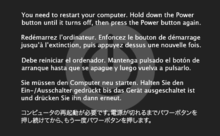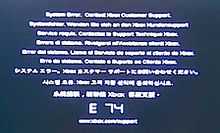Black Screen of Death


The Black Screen of Death (BkSoD[1]) is an error screen displayed by some operating systems after encountering a critical system error which can cause the system to shut down.
The Windows black screen of death
Windows 3.x
In Windows 3.x the black screen of death is the behaviour that occurred when a DOS-based application failed to execute properly. It was often known to occur in connection with attempting certain operations while networking drivers were resident in memory. (Commonly, but not exclusively, it was seen while the Novell NetWare client for DOS, NETX, was loaded.)
According to Wallace McClure of ASP.net, the phrase was originally coined in mid-1991 by Ed Brown, a technician with The Coca-Cola Company's IT department in Atlanta, GA. He reports that the company was rolling out Windows 3.0 within the Global Marketing group and when the users would attempt to run WordPerfect, they would randomly receive a BkSOD.[2]
Later versions of Windows
Windows 95, Windows 98, Windows 2000, Windows ME, Windows XP, Windows Vista, Windows 7, and Windows 8 also display a Black Screen of Death when the operating system cannot boot. This is usually due to a missing file.[3] This also happens when the user enables file compression on all files and the operating system compresses. Often the user must reinstall Windows, if the missing file is critical to the boot process. However, more often than not the boot screen will inform the user of the missing file. If the operating system is compressed, it will not be able to boot, even into safe mode.[4][5]
In late 2009 several new reports of the Black Screen of Death in Windows XP, Windows Vista, and Windows 7 emerged. At first several claims pointed at a Windows Update. It was later recanted by Prevx as an erroneous report.[6][7] Microsoft reported that no security update was causing the issue, and it may be tied to malicious software, or malware.[8][9] In other cases, the black screen of death was replaced with the Blue Screen of Death. The Black Screen of Death may also be caused by certain components of a computer becoming too hot (overheating).
Early builds of Windows 8 featured a black screen of death, in place of the traditional blue screen, that appeared to indicate a Stop error. This black screen of death was simplified compared to the previous blue screen, omitting instructions that the user is recommended to take.[10]
In game consoles

A black screen can be encountered on numerous other computer systems such as the Nintendo GameCube if the game disc is dirty or damaged or if there is an internal problem with the system such as an illegal operation. The message that displays on-screen is "An error has occurred. Turn the power off and check the Nintendo GameCube instruction booklet for further instructions."
On the Nintendo 3DS, reports were going on about a black screen of death after the console's release. It has been known to affect the SD Card, erasing memory. In order to try and fix the screen of death, Nintendo released an anti-virus to try and fix the screen, but failed. This is also common on the Wii U. On the PlayStation, a red screen of death would usually appear during an error, but if the internal laser is damaged, the start-up appears as usual, but then the screen cuts to a dark grey or black screen with a sinister scratching noise echoing. On the Nintendo Wii, if a saved game has been erased from the memory system, a black appears with a sign saying, "System files are corrupted." On the Xbox 360, if a hardware cable is not detected, a dark green or jet-black screen with an error screen, with a message written in different languages, while the red error rings appears on the console.
On Xbox One, if a damaged or dirty disc is inserted into the system, or there is a thunderstorm, a message will say "There is a problem with the Xbox One console. Please contact Xbox Support."
On the Sega Saturn, if all files are deleted, during a loading, or pressing the power button during erasing, a black screen will be displayed, along with the message "No signal." Afterwards, it goes to the Static, similar to Analogue TV. After the static, a Power Cut occurred when a Sega Saturn console. Backup RAM & the TV is damaged.
iOS
When an iPhone, iPad, or iPod touch is severely dropped or just freezes completely, upon reboot, the iDevice will be unable to load resources and hang at the kernel boot process - an Apple. Inc logo. On white colored iDevices, the kernel boot image is white on black instead of vice versa.
Sky
On Sky Boxes if a dirty viewing card is inserted, Series Link failure. Recording Failure, when ITV loses a signal, or if placed in a non-warm area such as hot, cold, damp, or dusty area, a message will say "My Sky Box is broken. Please contact Sky Customer Service".
See also
References
- ↑ Although the short form BSoD was once used to describe the Black Screen of Death, nowadays the said short form is used to describe the much more common Blue Screen of Death (for Windows) so as to avoid confusion between the Blue and Black Screens of Death.
- ↑ Wallace B. McClure (2004-02-24). "Origin of BSOD". Retrieved 2001-07-10.
- ↑ "How to fix MBR (remove multiple installations) and install Windows 7".
- ↑ "Black Screen on Boot". Support.microsoft.com. 2007-01-19. Retrieved 2012-01-08.
- ↑ "Computer stops responding with a black screen when you start Windows XP". Support.microsoft.com. 2011-02-03. Retrieved 2012-01-08.
- ↑ Erasmus, Jacques (2009-11-30). "Windows Black Screen Root Cause". Prevx.com. Retrieved 2012-01-08.
- ↑ Morris, Mel. "Windows Black Screen recap". Prevx.com. Retrieved 2012-01-08.
- ↑ "‘Black screen of death’ for some Windows users - Technology & science - Security - msnbc.com". MSNBC. 1/8/2012. Retrieved 2012-01-08. Check date values in:
|date=(help) - ↑ MSRCTeam (2009-12-01). "Reports of Issues with November Security Updates - MSRC - Site Home - TechNet Blogs". Blogs.technet.com. Retrieved 2012-01-08.
- ↑ Tom Warren (24 April 2011). "Microsoft switches to Black Screen Of Death (BSoD) for Windows 8". WinRumors.
External links
| ||||||||||||||||||||||